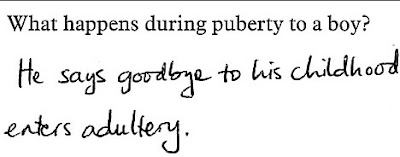Remember the Teenage Mutant Ninja Turtles?
Well, they were GOOD mutants, weren't they?
We all know that turtles become slow beings when they reach turtle-adulthood, and even when they are in their turtle-teens, they would have slowed down alot from when they were turtle-babies.
So how could they have become fast-moving ninjas fighting urban crime, alien invaders etc.?
Well, what happened was some part of the DNA in their cells mutated.
Changed in form, that is.
So what is DNA? Well, I haven't seen it for myself really but they say it's something in our cells that looks like a spiral staircase. Somehow this spiral entity stores all the information - the genes - that defines each one of us as a creation of God.
I have straight hair because that's written in my DNA - I have the straight-hair gene. I will have wavy hair only if the straight-hair gene mutates into a wavy-hair gene. Which can't be bad if I have the face to go with it but it doesn't really matter much either.
Mutation can be good however, in particular when it helps the mutant cope with his environments eg. colder winter temperatures, or thinner air or even life in the New York sewers, for the ninja turtles.
Sometimes though mutation can be bad. This happens when the body does not adapt well to the change and may then become susceptible to serious diseases, like cancer.
Remember the atomic bombs on Hiroshima and Nagasaki? And the Chernobyl nuclear fall-out? The radio-active material from these blasts caused mutations on a mega scale.
But please do not think that we are safe from such hazards.
Mutations can also take place without us knowing.
Sometimes substances present in what we consume can cause genetic mutation.
Like undercover agents, these substances work invisibly as agents of mutation. They are called mutagenic substances. They cause genes to mutate.
So if we consume substances that are mutagenic, they may cause mutation in certain genes that have already adapted well to our body chemistry.
Oh yes, CANCER. The big C.
We have heard of carcinogens, haven't we? Those substances that can cause cancer?
They are in fact agents of cancer. Nicotine in cigarette smoke is an example.
Interestingly there are hard-core smokers who live well into their nineties without getting cancer. I believe it's because they have genes that have adapted to the smoky, tarry environment within their lungs. And I believe that they are the exceptions to the norm.
And I believe for many smokers, this protective gene(s), in the course of time mutate, due to the actions of certain mutagens in the body which are present by way of exposure to or consumption of mutagenic substances...
...which results in the body becoming susceptible to the carcinogens in cigarette smoke which is when the smoker may contract cancer.
What should be good for such smokers then (and also for the unfortunate people exposed to secondary smoke) is to consume agents that can PREVENT the mutation of their protective genes, so-called ANTI-mutagenic substances.
Apparently, anti-mutagens exist. Take Japan, it is a nation of heavy smokers but it has one of the lowest rate of cancer occurrence in the world. (And the most ninjas?)
Anyway that, is my over-simplistic layman understanding of mutagens, carcinogens and anti-mutagens.
And why do I find them interesting?
It's because in the course of my looking-up on
sirih (betel-leaf in English) for my previous post, I came across a blog run by a Malaysian herbalist, it's called
Sembang-sembang Herba. The herbalist had argued that both
sirih and it's accompaniment pinang (areca-nut) DO NOT cause cancer as is widely believed, based on their anti-mutagenic and non-carcinogenic properties.
Do go there, have a read and you'll learn that
sirih and
pinang are in fact anti-ageing too - just short of being aphrodisiacs. You'll learn an age-old secret or two there as well.
Another thing I came across is that the Burmese word for sirih is
kunya and isn't it surprising that that is also the Malay word for "chew", chewing being the only way to enjoy
sirih!
As to the query whether there is anything for women that works also on men, below is an excerpt of an article, also by the same herbalist.
"Herbs Suitable for Women may be Disastrous for Men
For men only.
Use the following herbs with cautions:
Stop taking them if you notice sign of breast enlargement: Saw Palmetto (anti-androgen), Fennel , Aniseed , Kacip Fatimah, Fenugreek, Licorice, Yucca, Pomegranate, and Red Clover .
However, not all herbs, commonly taken as food which contain estrogenic phytochemicals bring about breast enlargement effects (in both sexes) including banana, tomato, pomegranate, fenugreek, parsley, carrot, dill, onion, garlic, alfalfa, mungbean, oregano, fennel, aniseed, grapefruit, tarragon, soy."
OK, you may read further
here
It was my hubby Red Alfa who made the above query, as he had discovered to his detriment how painful it was to over-indulge on soy-based protein supplements.
Back in the days (circa 2003) when he had just started bench-pressing in our bedroom, drinking protein supplements was part of his regime. Most sold on the market were whey-based, which he couldn't handle due to lactose intolerance which comes with having javanese roots and by virtue of which soy would be a natural choice, so we thought.
And so he bought soya protein at the pharmacist's a carton at a time and consumed them with relish.
But it was only when he started getting headaches akin to PMS migraines which made him demand a head scan at the hospital which revealed nothing, that we came across some information on the internet about the pre-cursors of estrogen that are present in soya that had affected him. Estrogen are female hormones and a true man wouldn't want to mess up his system with them. Fortunately they had only given him headaches and a new respect for women who suffer them. I'm not sure though whether any genes had mutated.
But tauhu, tempeh, and taucho do not have the same effect because of the fermentation process that the soya beans have been subjected to produce them. So it was a lesson learnt the painful way for hubby, who still has this habit of experimenting much too whole-heartedly with foodstuffs until they become "poisonous" to his body. Like eating menglembu groundnuts (read protein) by the packets every night after dinner until his gout played up. Or drinking UHT milk by the jugs until a trainer at the gym commented on his belly saying "AHA! YOU HAVE BEEN DRINKING MILK!" And now experimenting with mixing vegetable and fruit juices into yogurt and milk - and he seems to be tolerating that so far.
Here and
here is where you can read up on the unwanted effects of soya - the question of which is an on-going controversy in the West actually.
Thanks for making it till the end of this post, do have a good weekend and for Muslims, it's the next 10 days before the last 10 days of Ramadhan, may it be good for you, Insya Allah.














































